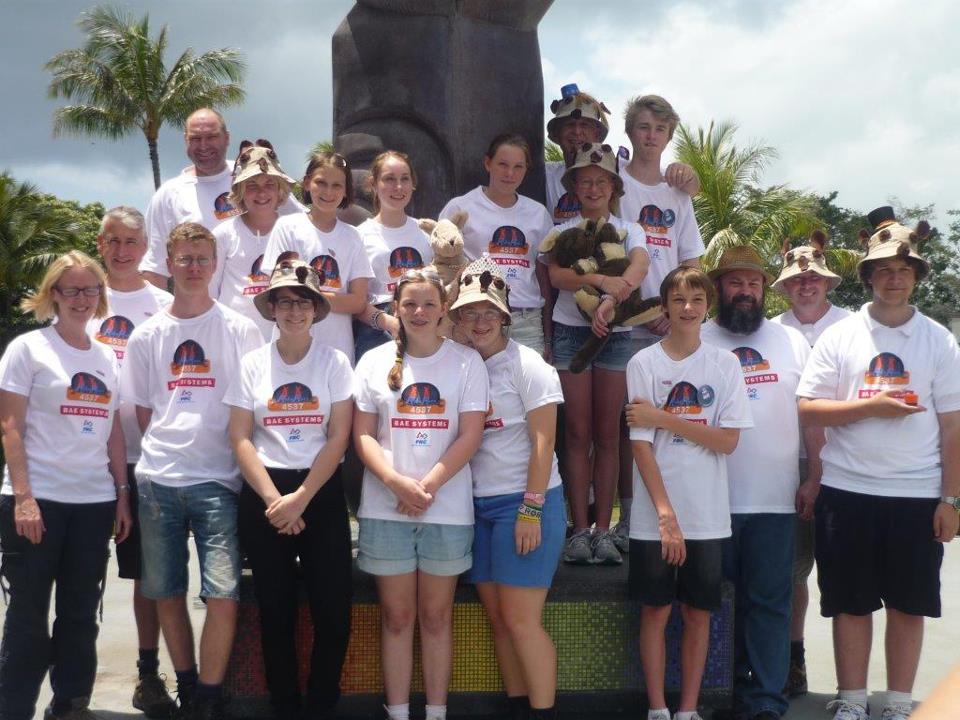The FIRST Robotics Competition (FRC) targets high school students, although primary school students in year seven are also welcome to join. The competition follows a pattern not unlike the FIRST Lego League, where an annual challenge is released and the students are asked to build robots that can overcome the tasks. However, while FLL asks students to build small, Lego-based robots, in the FRC the robots can stand up to 2 meters tall, weigh in excess of 50 kg, and travel at close to 20 km/h. These are big robots.
The Challenge
Challenges vary greatly from year to year. In 2014, teams were asked to build robots that could throw a massive inflatable exercise ball two metres into the air. In 2015 the challenge was to build a robotic forklift that could create a tower of up to six crates and place a recycling bin on the top. In 2016 the competition went medieval, with teams competing to build robots that could cross medieval-themed defences, such as a portcullis and moat, to shoot boulders (technically foam balls) at a tower, and, if successful, climb that tower at the end. What they all have in common is an intense and strict six weeks to build the robot, and an exciting time in the competition.
Competition and Travel
When complete, the robots compete in an international competition of more than 6000 teams, supported by a travelling team of students and mentors. Regionals are held in Sydney each year, but there is also an option of travelling to an overseas event – in the past the ‘Roos have competed in Hawaii and St Louis. Success at a regional event can lead to an invitation to compete in the world championships in the United States.
Skills
Students pick up a wide variety of skills, from the use of various tools to fabricate the robot, through to design and cad skills, electrical engineering and programming. Outside of the build students can learn graphic design, photography, video editing, public speaking, management and leadership, and develop their social skills.
Annual Timetable
The build season runs over six weeks from early January to mid February. This coincides with the last three weeks of the summer school holidays in South Australia. The regional competitions are held in March and April, and successful teams will compete in the World Championships in April. A second, off-season event is held in Sydney in July, the Duel Down Under, and new students are especially encouraged to take part.
During the year the RoboRoos hold regular club days and evening events, and between July and November we offer a range of training opportunities – from power tool certification through to computer programming. These are often conducted in combination with the South Australian universities.
Member Specialities

Each member is encouraged to choose one or more sub teams, although we’re extremely happy to see students try out as many roles as they like.
- Design: Our design team is responsible for solving the problems posed by each challenge, and providing the other subteams with a design to follow.
- CAD: Using Computer Aided Design tools, such as Autodesk Inventor and Soildworks, the CAD team translates the concept produced by the designers into a model that the mechanical team can follow.
- Mechanical: The mechanical team is responsible for building and maintaining the robot. They use a variety of tools, and are taught a wide range of engineering skills.
- Electrical: Under the supervision of mentors, students in the electrical team build the electrical system, wiring up the power, motors, computer control system and the essential flashing lights.
- Programming: The primary role of the programming team is to use Java to program the robot, but they are also responsible for the scouting software and can take on other IT tasks.
- Drive: At competition three of our student members need to be responsible for the operation of the robot on the field.
- Pit crew: The competition is hard on the robots. The pit crew keep everything running smoothly.
- Media: Photography, writing, poster design and filming.
- Outreach: School visits and community displays
Joining
The best time to join is between April and November, after the completion of the year’s competition but before the start of the next season. Training takes part in the second half of each year. Currently the team has a little over 30 members, and we have room to continue to grow. Email roboroos@roboroos.org.au for more information – we’d love to hear from you!
